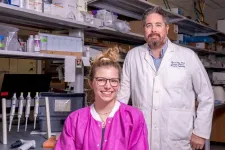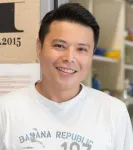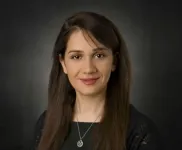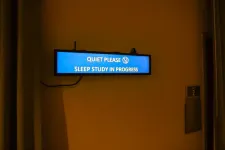(Press-News.org) Key takeaways
The 7.5- magnitude earthquake beneath Japan’s Noto Peninsula on Jan. 1, 2024, occurred when a “dual-initiation mechanism” applied enough energy from two different locations to break through a fault barrier – an area that locks two sides of a fault in place and absorbs the energy of fault movement, slowing it down or stopping it altogether.
An international team of researchers led by UCLA graduate student Liuwei Xu, professor Lingsen Meng and UC Santa Barbara’s Chen Ji analyzed a preceding seismic swarm and identified a previously unknown barrier in the region of the swarm.
The team’s data collection methods could aid future research into the conditions and probabilities of dual-initiation earthquakes.
The first seven months of 2024 have been so eventful, it’s easy to forget that the year started off with a magnitude 7.5 earthquake centered beneath Japan’s Noto Peninsula on New Year's Day. The earthquake killed more than 280 people and damaged more than 83,000 homes.
Geologists have now discovered that the earthquake began almost simultaneously at two different points on the fault, allowing the seismic rupture to encircle and break through a resistant area on the fault known as a barrier. This rare “dual-initiation” mechanism applied intense pressure from both sides of the barrier, leading to the powerful release of energy and substantial ground shaking across the Noto Peninsula.
The Noto earthquake was preceded by intense seismic swarms, which are sequences of many small earthquakes that can sometimes lead to a larger, catastrophic event. By using advanced seismic and geodetic technologies, the research team meticulously analyzed the movements within the Earth during this swarm that led to the earthquake.
The study, published in the journal Science, offers insight into the role of fault barriers, also known as asperities, in earthquake genesis, and will help improve seismic risk assessments and future earthquake forecasting.
Earthquakes happen when fractures in the Earth’s crust, known as faults, allow blocks of rocks on either side of the fault to move past each other. This movement is localized, not continuous along the fault line, because the line is not even or smooth, which dissipates energy and eventually stops the movement.
A barrier is a rough area that locks the two sides of a fault in place. Barriers absorb the energy of fault movement, slowing it down or stopping it altogether. But there’s only so much energy the barrier can absorb, and under the right conditions, the pent-up energy causes it to break violently, leading to strong shaking. A swarm of small earthquakes might not be enough to break a barrier, but if much stronger subsequent movement occurs on the fault, the barrier’s rupture will release all that stored-up energy.
Led by Lingsen Meng, a UCLA associate professor of earth, planetary and space sciences, UCLA graduate student Liuwei Xu and UC Santa Barbara geophysics professor Chen Ji, an international team of researchers from the United States, France, China and Japan analyzed geospatial data and recordings of seismic waves to understand the relationships between the swarm of smaller tremors and the larger earthquake that followed them. They identified a previously unknown barrier in the region of the swarm.
To their surprise, the New Year’s Day earthquake began almost simultaneously in two separate locations on the fault. Energy from each location moved toward the barrier, causing a violent rupture and extremely strong shaking.
“The earthquake started in two places and circled together,” Meng said. “The first one started waves that traveled fast and triggered a different epicenter. Then both parts propagated outward together and met in middle, where the barrier was, and broke it.”
The mechanics resemble bending a pencil on both ends until it snaps in the middle.
The finding was surprising because although dual initiation, as the process is known, has been seen in simulations, it has been much harder to observe in nature. Dual-initiation mechanisms require just the right conditions, which can be set in the lab but are less predictable in the real world.
“We were able to observe it because Japan has very good seismic monitoring stations and we also used GPS and satellite radar data. We grabbed all the data we could find! It’s only through all of this data together that we got really good resolution on this fault and could get into these fine details,” Meng said.
The vast majority of earthquakes don’t have anywhere near this level of data collected, so it’s possible that earthquakes with dual-initiation mechanisms are more common than geologists think.
“It could be that through better imaging and resolution, we’ll identify more like this in the future,” Meng said.
Earthquakes with dual epicenters have a higher risk for stronger shaking because there is stronger movement. Meng’s group plans to consider future scenarios to learn about the conditions and probabilities of these earthquakes.
"Our findings emphasize the complex nature of earthquake initiation and the critical conditions that can lead to large-scale seismic events," Meng said. "Understanding these processes is vital for improving our ability to predict and mitigate the impacts of future earthquakes."
END
Two epicenters led to Japan’s violent Noto earthquake on New Year's Day
A rare “dual-initiation” mechanism ruptured a barrier on the fault during the Jan. 1 shaker
2024-08-23
ELSE PRESS RELEASES FROM THIS DATE:
A leaky sink: Carbon emissions from forest soil will likely grow with rising temperatures
2024-08-23
Photos
The soils of northern forests are key reservoirs that help keep the carbon dioxide that trees inhale and use for photosynthesis from making it back into the atmosphere.
But a unique experiment led by Peter Reich of the University of Michigan is showing that, on a warming planet, more carbon is escaping the soil than is being added by plants.
"This is not good news because it suggests that, as the world warms, soils are going to give back some of their carbon to the atmosphere," said Reich, director of the Institute for Global Change ...
Rice bioengineers develop lotus leaf-inspired system to advance study of cancer cell clusters
2024-08-23
HOUSTON – (Aug. 23, 2024) – The lotus leaf is a pioneer of self-cleaning, water-repellant engineering. Water droplets all but hover on its surface, whose unique texture traps air in its nanosized ridges and folds.
Rice University bioengineers report harnessing the lotus effect to develop a system for culturing cancer cell clusters that can shed light on hard-to-study tumor properties. The new zinc oxide-based culturing surface mimics the lotus leaf surface structure, providing a highly tunable platform for the high-throughput generation of three-dimensional nanoscale tumor models.
The superhydrophobic array device (SHArD) designed by Rice bioengineer Michael King and ...
To mask or not to mask: That is still the question
2024-08-23
CHICAGO --- Despite the association between mask mandates/mask wearing and reduced death rates during the pandemic, masking remains controversial and highly politicized, with many people still asking, “do masks work, and should they be recommended?”
In an editorial about the use of surgical face masks in public, published today, Aug. 23, in The BMJ, Northwestern Medicine internal medicine experts Drs. Jeffrey Linder and Rachel Amdur make the case for masking but acknowledge it’s not a cut-and-dried topic.
The ...
A switch for immune memory and anti-tumor immunity
2024-08-23
AUGUST 23, 2024, NEW YORK – A Ludwig Cancer Research study has identified a metabolic switch in the immune system’s T cells that is essential to the generation of memory T cells—which confer lasting immunity to previously encountered pathogens—and a T cell subtype found in tumors that drives anti-tumor responses during immunotherapy.
Led by Ludwig Lausanne’s Ping-Chih Ho and Alessio Bevilacqua and published in the current issue of Science Immunology, the study identifies PPARβ/δ, a master regulator of gene expression, as that essential molecular switch. Ho, Bevilacqua and their colleagues also show that the switch’s dysfunction compromises ...
Study finds nearly half of U.S. counties have at least one ‘pharmacy desert’
2024-08-23
COLUMBUS, Ohio – Nearly half of counties in the United States have at least one ‘pharmacy desert’ where there is no retail pharmacy within 10 miles, according to a new study published by researchers at The Ohio State University Comprehensive Cancer Center – Arthur G. James Cancer Hospital and Richard J. Solove Research Institute (OSUCCC – James).
“As pharmacies close, more and more Americans are left without easy access to medications, with disproportionate consequences on certain communities. We found that patients in counties with higher social vulnerabilities and fewer primary care providers were up to 40% more likely to reside in a region ...
MSU study finds placebos reduce stress, anxiety, depression — even when people know they are placebos
2024-08-23
MSU has a satellite uplink/LTN TV studio and Comrex line for radio interviews upon request.
EAST LANSING, Mich. – A study out of Michigan State University found that nondeceptive placebos, or placebos given with people fully knowing they are placebos, effectively manage stress — even when the placebos are administered remotely.
Researchers recruited participants experiencing prolonged stress from the COVID-19 pandemic for a two-week randomized controlled trial. Half of the ...
MSU discovers method for CRISPR-based genome editing in Nile grass rats
2024-08-23
EAST LANSING, Mich. – A team of researchers at Michigan State University has discovered a set of methods that enabled the first successful CRISPR-based genome editing in Nile grass rats.
The study, published in BMC Biology, is the first to successfully edit genomes in Nile grass rats. As diurnal rodents, Nile grass rats have similar sleep/awake patterns to humans which could be advantageous in preclinical or translational research.
Currently, preclinical research relies heavily on laboratory mice, which are nocturnal rodents who are active at night and sleep during the day. With these different sleep patterns, diurnal and nocturnal ...
UVA engineering professors target inclusive AI education with $1 million grant
2024-08-23
Underserved high school students often lack access to artificial intelligence education that could prepare them for future careers in technology. Researchers at the University of Virginia School of Engineering and Applied Science and Clemson University are hoping to change that.
To help bridge the educational divide, the research team received a $1 million grant from the National Science Foundation to democratize access to AI education. Future fair and equitable technologies depend on a robust AI education, and expanding access to that education is crucial.
The project is part of the NSF’s Experiential Learning for ...
Kids now see fewer TV ads for unhealthy food and drinks, but exposure remains high
2024-08-23
Children’s exposure to food and drink ads during kids’ TV shows has dropped substantially since food and beverage makers pledged to stop advertising unhealthy fare during children’s TV shows. Yet, according to research from the University of Illinois Chicago, children under 12 still see more than 1,000 food-related ads a year, most of them for unhealthy products.
For the study, published in JAMA Network Open, researchers analyzed television ratings and advertising data from 2013 through 2022. The study authors found that a dramatic decline in food and drink advertisements during kids’ shows did not ...
Good sleep habits important for overweight adults, OHSU study suggests
2024-08-23
New research from Oregon Health & Science University reveals negative health consequences for people who are overweight and ignore their body’s signals to sleep at night, with specific differences between men and women.
The study published this week in The Journal of Clinical Endocrinology & Metabolism.
“This study builds support for the importance of good sleep habits,” said lead author Brooke Shafer, Ph.D., a postdoctoral researcher in the Sleep, Chronobiology and Health Laboratory in the OHSU School of Nursing. “Sleep practices, like going to bed when you’re tired or setting aside your screen at ...
LAST 30 PRESS RELEASES:
Researchers use robotics to find potential new antibiotic among hundreds of metal complexes
Gut bacteria changes at the earliest stages of inflammatory bowel disease
Scientists develop new way to “listen in” on the brain’s hidden language
Brain research: “Pulse generators” grow and shrink as memories are formed
For teens, any cannabis use may have impact on emotional health, academic performance
School meals could unlock major gains for human and planetary health
Menopause hormone therapy does not appear to impact dementia risk
Signature patterns of brain activity may help predict recovery from traumatic brain injury
Dresden study uncovers new key mechanism in cancer cells
New species are now being discovered faster than ever before, study suggests
Cannabis-based products show limited short-term benefit for chronic pain, with increased risk of adverse effects
Cannabis products with more THC slightly reduce pain but cause more side effects
Clearing the brain of aging cells could aid epilepsy and reduce seizures
Brain injuries linked with potential risk of suicide, new study finds
New technique lights up where drugs go in the body, cell by cell
New study finds movement of fishing fleets can reveal shifts in marine ecosystems
Embargoed: New evidence points to potential treatment for vascular dementia
Study uncovers disrupted brain balance in alcohol dependence
Working in groups can help Republicans and Democrats agree on controversial content moderation online
Structural findings reveal how distinct GPCR ligands create different levels of activation
Anything-goes “anyons” may be at the root of surprising quantum experiments
UC review: Maximizing workplace opportunity for veterans
From generation to complex control: Metasurfaces make perfect vortex beams "within reach"
Thin-film lithium niobate-based detector: recent advances and perspectives
Exploring why some people may tend to persistently make bad choices
How cells balance their protein levels
Nirsevimab vs RSVpreF vaccine for RSV–related hospitalization in newborns
Effectiveness and impact of maternal RSV immunization and nirsevimab on medically attended RSV in US children
AI gives scientists a boost, but at the cost of too many mediocre papers
Next-generation vision model maps tree growth at sub-meter precision
[Press-News.org] Two epicenters led to Japan’s violent Noto earthquake on New Year's DayA rare “dual-initiation” mechanism ruptured a barrier on the fault during the Jan. 1 shaker




